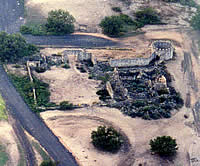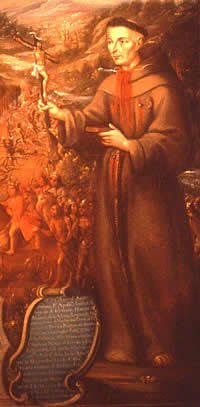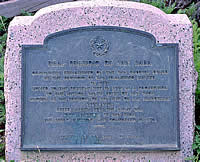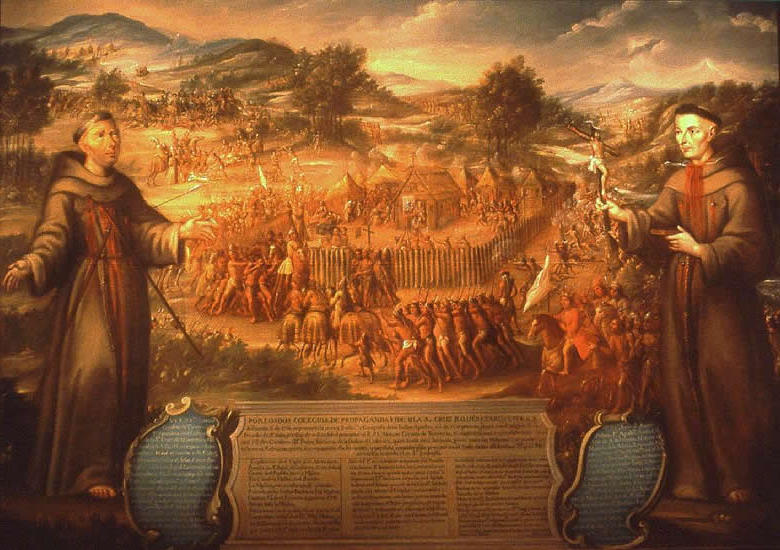
Musket balls found in the vicinity
of the church at Mission San Sabá where Spaniards
were surrounded by 2000 Wichita, Comanche, and Caddo
warriors.
|
|
Burned and shattered, the abandoned Mission San
Sabá passed into history and legend.
|

Aerial view of Presidio San Sabá
(formally, Presidio San Luis de las Amarillas) near
Menard, Texas. The presidio was partially (and badly)
rebuilt in 1936. Today the deteriorating ruins are surrounded
by a golf course. Fortunately, a broad coalition of
Menard's citizens are undertaking an ambitious restoration
program aimed at preserving the site and accurately
reconstructing enough of the fort to give visitors a
keen sense of its past. Photo by Jay Kothmann.
|
 Father Alonso de Terreros, head of
the mission and cousin of "the illustrious Knight
don Pedro Terreros of the order of Calatrava,"
as the wealthy silver magnate who commissioned the painting
had himself referred to in the central text panel between
the priests.
|
|
On the morning of March 16, 1758, Mission Santa
Cruz de San Sabá, a small, hastily constructed compound
enclosed by a wooden palisade, was surrounded by 2000 hostile
Indians including Wichita, Comanche, and Caddo warriors. The
three Spanish priests in residence tried to placate the allied
native force with gifts and offers of safe passage to the
nearby Presidio, but the palisade was soon overcome and Father
Terreros, the mission leader, was killed along with several
others. A small group of people who survived the attack took
refuge in the church, the mission's largest structure. Meanwhile,
the palisade and several buildings were set on fire as the
Indians sacked the place and began celebrating victory. Sporadic
fighting continued as the Indians fired their French muskets
at the church and tried to gain entry.
Four miles upstream, the 30 soldiers at the
Presidio San Sabá heard the terrible din, saw the smoke
from the fires, and were soon surrounded themselves. While
they were able to keep the Indians at bay, the soldiers could
not come to the rescue of the mission—two-thirds of the
garrison was away on various forays. As night fell, the victorious
allied natives roasted several slaughtered oxen and feasted
a short distance from the beleaguered missionaries. While
the victorious Indians were feasting, the survivors led by
Juan Leal, escaped the burning church under cover of darkness
and made their way to the Presidio, many of them badly wounded.
The arrival of additional reinforcements (returning soldiers)
at the Presidio the next day apparently saved the garrison
from a similar fate as that of the mission.
Burned and shattered, the abandoned Mission
San Sabá passed into history and legend, illustrated
by the famous mural shown above. Presidio San Sabá
was strengthened and manned for another decade because of
its strategic role in Spanish mining operations nearby, but
then it, too, was abandoned as the Spanish frontier retreated
southward. The ruins of the presidio remained as highly visible
reminders of the Spanish presence. But the remnants of the
sacked mission, never substantial to begin with, dwindled.
Picked over time and again by souvenir hunters, it disappeared
as a known place shortly after 1900. Historians and archeologists
began trying to relocate Mission San Sabá in the mid-1960s,
but it was not until 1993 that the search met success.
This exhibit tells the story of the rediscovery
of Mission San Sabá and the archeological investigations
that followed. While some of the history of the place and
the period is presented here (see Spanish
Motives), there are many excellent historical accounts
that give more of the details (see Credits
& Sources). The story of Mission San Sabá and
its rediscovery presents fascinating lessons in how events
are viewed by history as well as the interplay between history,
archeology, and luck.
The archeologist who narrates the remainder
of this exhibit is Dr. Grant D. Hall, Associate Professor
of Anthropology at Texas Tech University. Born and raised
in Texas, Hall has carried out numerous archeological investigations
in the coastal plains, south and central Texas, and the Maya
Lowlands. Since 1990, he has taught at Texas Tech and involved
his undergraduate and graduate students in an ambitious regional
research program centered on the San Sabá River valley.
Every summer a Texas Tech field school is held in the region,
usually at localities between Menard and San Sabá,
Texas. The students always get a good basic training in archeological
field methods as well as the chance to help uncover San Sabá
history and prehistory.
Today Hall is joined at Texas Tech by Dr. Tamra
Walter, a specialist in historical archeology. They and their
students are excavating Presidio San Sabá to reveal
more of its history and obtain the evidence needed for a historically
accurate reconstruction. They enjoy the strong support of
the people and civic leaders of Menard who hope to make the
Presidio a focal point for tourism and history.
"The Destruction of Mission San Sabá"
The famous mural was painted in Mexico City,
perhaps in 1765, about 6 years after the mission was destroyed.
The painting was commissioned by Don Pedro Romero de Terreros,
cousin of one of the first priests killed in the attack. Terreros
had made a fortune in mining down in Mexico and put up the
money to finance the Mission San Sabá. Though the artist
was never in central Texas, he was advised by eyewitnesses
as to the appearance of the mission and the details of the
Indian attack. A careful examination reveals that the mural
tells the story of the attack, including the fates of the
two priests who were killed. The blue shields beside each
priest contain their biographical sketches.

Archeological findings at the mission confirm
that the mural is fairly accurate. The houses, church, and
stockade were built of wooden posts and poles. The roofs were
thatch. This building technique is known as wattle-and-daub
in English. In Spanish, the method is known as jacal (pronounced
HAH-call), and it is still in use in Mexico and other Latin
American countries. In addition to the mural and verbal descriptions
of how the mission looked, we have fired clay daub and post
stains uncovered at the site to provide further evidence of
the size and configuration of the mission compound and the
methods used in its construction.
The mural is thought to be the earliest painting
by a professional artist depicting an historical scene in
Texas. It is still in the possession of Terreros family descendants
in Mexico. The family shipped the mural to the United States
for sale in the early 1990s. Controversy ensued and the Mexican
government claimed the mural as national patrimony. It was
returned to Mexico.
|

Remnant of burned post that once
formed part of the mission walls.
Click images to enlarge
|
|
As night fell, the victorious allied natives roasted
several slaughtered oxen and feasted a short distance
from the beleaguered missionaries.
|

Historical Marker at Presidio San
Sabá.
|

Dr. Grant D. Hall, leader of the
archeological investigations at Mission San Sabá.
Here he poses at the ruins of Presidio San Sabá
along with several of his students. Photo by Mark Mamawal,
Texas Tech Univeristy.
|

The priests in the mural are depicted
in gruesome detail showing the manner of their death.
The blue shields beside each priest contain their biographical
sketches.
|
|








